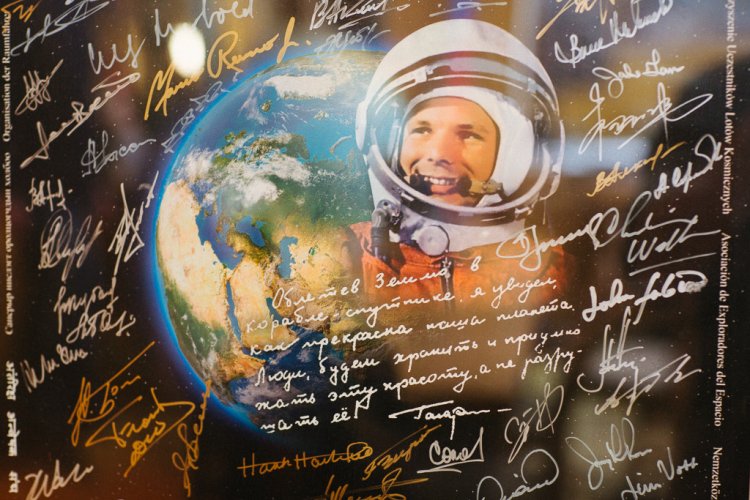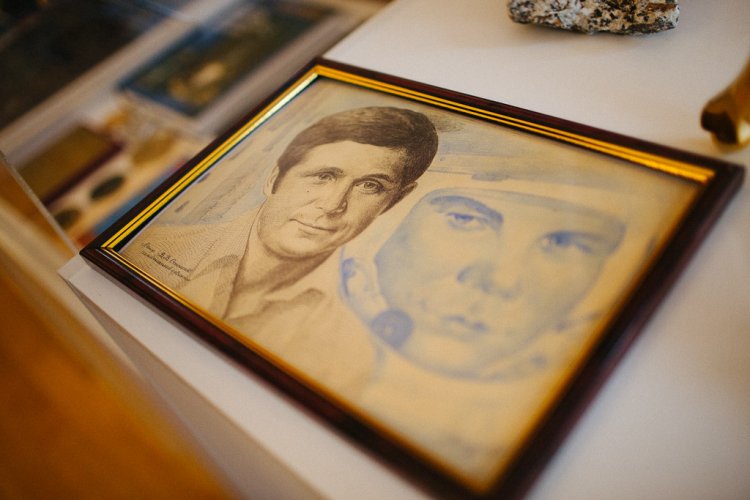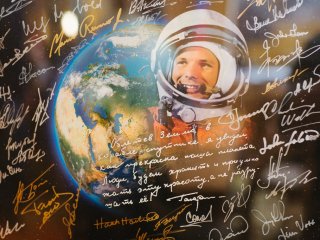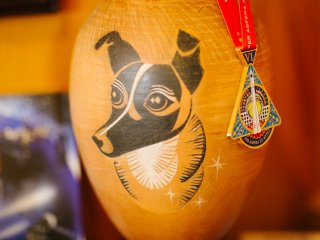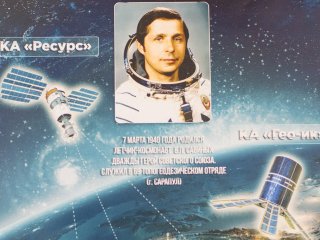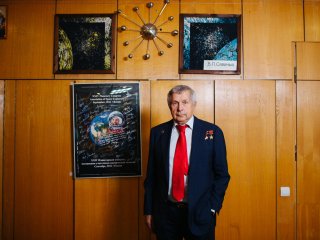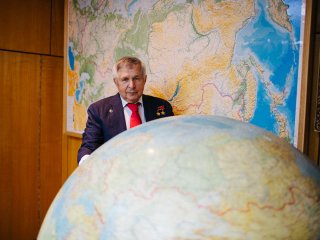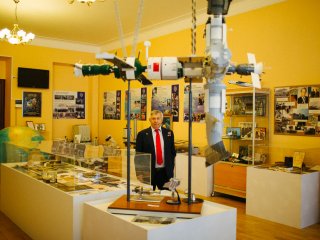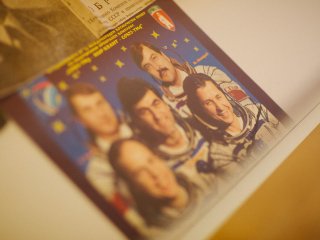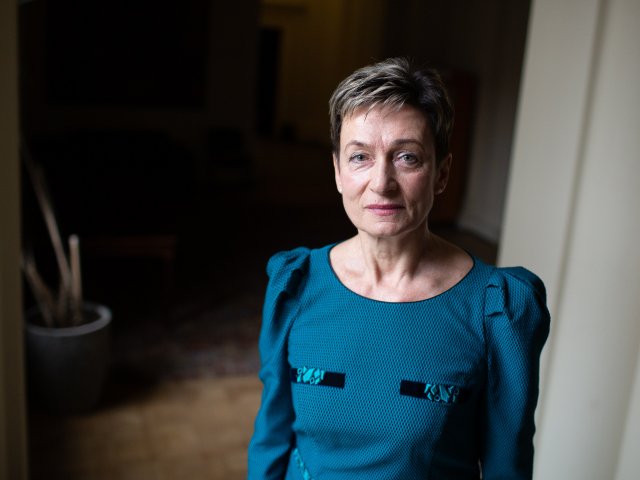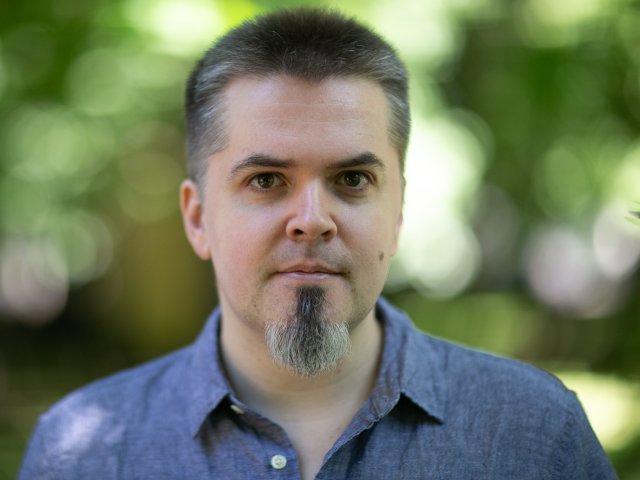Academician of RAS Viktor Savinykh, two times Hero of the Soviet Union, who has performed three spaceflights as onboard engineer, recalls his flights, reasons upon the importance of scientific research and education of the younger generation.
Viktor Savinykh is a modest and witty person. No symptoms of star sickness are observed in cosmonaut No 50, though it would seem that there are grounds for it. He is a legendary person indeed.
The cosmonaut talks about his collection of rhinoceroses laughing. Once someone gave to him this animal as a gift. His wife told him, “You dig in your heels as rhinoceros for the whole of your life,” and bought another one for him. Now, Viktor Petrovich brings them from all over the world. His collection includes 500 pieces – a real Zoo!
He proudly shows around the MIIGAIK’s museum. It is full of real rarities – from geodesic instruments of Peter the Great’s time to the spacesuit he wore while bringing back to life famous station Salyut-7. This flight was the most difficult one technically in the history of cosmonautics.
Viktor Savinykh
– Viktor Petrovich, you were born in Kirov region, in the village with poetic name of Beryozkiny. You studied at a railroad technical college, graduated from MIIGAIK (Moscow State University of Geodesy and Cartography) with honors and continued your career in space industry having taken a job at RSC Energia, where you dealt directly with spacecraft optical systems and gained a reputation of excellent engineer. Why did you join the cosmonaut team?
– I did not dream of spaceflights of course. I do not even remember when exactly I learned about Tsiolkovsky. In our village, nobody knew Tsiolkovsky, while the teachers of physics and history did not tell us about him. However, I saw many stars, as the sky above our village was always clear. I recall coming home at night from the cinema and seeing Orion right above our house. I always looked at Orion’s Belt while knocking at the door. Later, I would look at this star during my spaceflights.
My childhood was hard. I was born in 1940 and remember how my father went to war. I was a small boy at that time. He was riding on a cart with a kitbag in hand. My mother walked side by side with the cart dragging me by the hand.
My father came back in 1946. It was a lean year, and life was hard. We would collect potatoes which had been left in the field and spent winter there waiting for horse-tail herbs to grow. This herb was very tasty when young. We had a cow, and I would eat them with milk.
In 1947, I went to school. This year was also hard. I had never been on the occupied territory – Vyatka region was far from the frontline – yet I saw Germans. Many of them were taken prisoner in 1942 when we defeated the German army at Stalingrad. At that time all schoolchildren studied at home for several years.
– It is like the situation we see now.
– Yes, indeed. However, we had no computers. The kids would gather in larger house – ten children in one room – and study, while Germans lived in the building of our school. It was annoying to see the fascists there, while we had to study at home. Perhaps, it is the reason why I hated German language and would not learn it. Moreover, there was no good teacher of German at our school. That is why I failed to enter the Perm University, though I had dreamed of studying geography there. The points I gained at the exams to the University allowed me to enter the railroad technical college. There was no retreat: the parents told me not to come back to the village, as they lived poorly.
By the way, being a student of the technical college, I saw the flight of the first sputnik. It was in October 1957. Everybody would run out in the street and look. There was a mini-park by name of Kozy Zagon (goat cote) near our hostel, and we watched the sputnik’s flight from there. To be exact, we thought that it was sputnik. Later, I found out that it was the last rocket stage. However, it was interesting to watch this object flying.
I did not dream about space at that time though having read a book about Tsiolkovsky and rockets. After graduating from the technical college, I worked in Sverdlovsk as railroad technical specialist for a short period of time. I was in charge of very long permanent track division including many tracks, rails, two bridges and two tunnels. I mastered the profession of railway man and was promoted to foreman. Then, I was enlisted in the army and found myself in survey troops.
– So, your profession can be traced back to army service, can’t it?
– Yes, I was enlisted in geodesic troops, yet later all those who had graduated from railroad technical colleges were sent to build the railway to Ob River, as a grand project was started being implemented in the north of Urals at that time – a new deposit of oil and gas was discovered there.
One morning, the barracks orderly shouted, “Company, hit the deck! Battle alarm!” We put on the uniform quickly, took the rifles and rucksacks. So, we stand in the corridor and hear Levitan’s voice from the radio speaker, “An important message of TASS will be broadcasted in several minutes.” Complete silence in the corridor. It was 1961, the year of Cuban Missile Crisis.
– Did you feel scared?
Photo: Andrey Luft/Scientific Russia
– Yes, I did. Powers’ aircraft had just been shot down above Sverdlovsk. We are standing, while the officers walk along the row, but give no commands.
Then we heard Levitan’s voice again, “Today, a powerful booster has put into orbit the spacecraft piloted by (makes a pause) Yuri Alexeyevich Gagarin, citizen of the USSR!”
Silence followed. Then, loud Hurrah! sounded. The soldiers started tossing their hats. As for shooting, we did not do it. The senior officer gives command, “Battle alarm over! Everybody goes to the meeting.” This is how we heard about Gagarin.
Next day, the news was published in newspapers. When the training period was over, we were sent to taiga to build the railroad, and I served faithfully to geodesy, cartography and railway there for two years.
– Was it that time that the decision to enter MIIGAIK was made?
– Yes. I was walking with the theodolite ahead of the builders paving the way for them and cutting down the trees. Suddenly a though came to my mind, “I must enter MIIGAIK. At that time, I knew that there was an optical faculty at the institute.
– The knowledge of German language was not required this time, was it?
– That very year, the exam in German was cancelled. I entered two universities at once – MIIGAIK and MIIT (Moscow Institute of Railway Transport Engineers). For some time, I attended both of them not knowing which of them to choose. At MIIT, I entered the department of Bridges and Tunnels. It was a very prestigious profession. Then, it so happened that I went to the collective farm (Soviet practice of sending students to reap harvest) with the students of MIIGAIK and, therefore, remained a student of this educational establishment.
– After graduation you received job assignment at RSC Energia, didn’t you?
– I studied at the department of optical electronic instruments which implemented joint projects with Sergey Korolyov’s organization. He was alive at that time. Unfortunately, I did not have a chance to work with him, as he died when I came.
At that time, everybody thought about making a flight to the Moon, and we were designing a lunar module. I was in charge of designing the instrument allowing the pilot to orient during landing. The lunar flight was not performed, and our engineers started thinking about some other breakthrough. Thus, the idea of a long-term orbital station was suggested, and they began designing Salyut-1. It took two years to make it.
I have many times been to the launching site. I remember well Nikolay Rukavishnikov and Vladimir Shatalov making their spaceflight. They managed to dock with the station, yet coupling failed: they could not get into the station. I have often communicated with cosmonauts. Once, after the lecture in optics that I delivered in the Star City, Rukavishnikov asked me, “Are you satisfied with reading lectures alone? Don’t you want to make a spaceflight?”
I answered that I had not thought about it. He made me file an application, while I filed it, had a medical check and was enlisted in the cosmonaut team in 1968.
– Yet, you made a flight not right away.
– My first crew included Leonid Kizim, Oleg Makarov and Viktor Savinykh. We formed a backup crew, but were getting prepared to the full extent. Later, only two cosmonauts flew to space – Vladimir Aksyonov and Yuri Malyshev. Then, I found myself a member of the backup crew again for half a year. Suddenly, it so happened that somebody had to fly urgently to Salyut-6, and I was sent there with Vladimir Kovalenok.
– I know that this flight was a surprise to you. Yet, something broke down on the station and professional engineering work was required.
– Yes, it came quite unexpected. I was a member of the third backup crew. The first one included Vyacheslav Zudov and Valery Rozhdestvensky, and their turn seemed to come. Yet after passing the exams, Glushko said that our crew would make the flight, as we passed the examinations better.
I knew Soyuz-T very well. It was a new spacecraft, and the commanders were not ready enough for it. Kovalenok knew Salyut-6 station well, so they formed a crew of the two of us, and we got prepared for the flight in half a year. Moreover, Intercosmos Program was being completed, and two international crews were to visit the station at all costs. First, Vladimir Dzhanibekov and a Mongolian cosmonaut flew to the station, while the second crew included Romanians and Leonid Popov. Thus, we completed the experiments with Mongolians and Romanians, made good photos of Mongolia and issued excellent cartographic material.
Photo: Andrey Luft/Scientific Russia
– So, you continued dealing with geodesy and cartography in space, didn’t you?
– ДYes, I was interested in this work.
– Did you like staying in space? You got addicted, didn’t you?
– Yes, I liked being in space and got addicted. People often ask me what book I was reading there. At leisure, I did nothing but look at the Earth through the viewing port. I saw serious problems of the Aral Sea and made a lot of photos. At that time, they had just started taking water from Syr-Darya, and there were many abuses related to this project. I saw the Great Lakes and was surprised with the fact that they were so dirty. In general, ecology enjoyed priority among my areas of research. Besides, I studied the atmosphere. It was during the flight that I saw the luminous clouds for the first time and would spend a lot of time studying them. I did not even sleep at night, as they could be seen only at nighttime.
– As is known, your second flight was the most complex one technically in the history of global astronautics. You were to bring back to life Salyut-7 station which had drifted out of control. We interviewed Vladimir Dzhanibekov, and he said that there had been nothing heroic in this work. You had just done your parts, and he had no doubts the crew’s ability to do it. What about you?
– I learned about the problem earlier than Dzhanibekov did, as I was getting ready for flying to Salyut-7. The crew consisted of Vladimir Vasyutin, Viktor Savinykh and Alexander Volkov. The flight program was very interested and involved a lot of spectrum equipment, so I joined this crew to deal with scientific research.
During one of the training sessions, however, we learned that something had gone wrong. We went to the MCC immediately, and they highlighted the situation to us. The station came to the area of radio visibility: no problems. The operator saw that uplink transmitters were using the second setoff equipment. Nobody understood that the station had gone crazy and switched over to the second set of equipment. Without pausing to think or consulting the designers, the operators gave a command to switch over to the first set. However, the station was in the area of Ussuriysk at that time. It started the second revolution and came to the area of Yevpatoriya.
The operators looked at the display and saw solid line on the screen. There was no information about the station’s work. Everybody realized that the station had stopped functioning. What had happened? It might be either a collision with meteorite, fire, or something else. The MCC began monitoring the station using antiaircraft systems and saw that it was an integral object. It was clear that only a crew can reactivate the station.
The commanders started looking for the candidates. Our crew was to fly. However, it included two young cosmonauts who had not made spaceflights yet, and, moreover, Vasyutin had never coupled with the station, so the decision to look for a commander was taken.
There were three candidates. Kizim who had just come back from the station was not yet ready for the flight. The second candidate was Yuri Malyshev. Yet, he had made his flight long ago and docked with the station manually. The third candidate was Dzhanibekov who had been decommissioned for health reasons.
– Are you serious?
– There were issues with his state of health, and he was decommissioned. Leonov persuaded him to undergo medical examination. He said, “I would be only pleased to make a flight.” When asked whom he would like to fly with, he suggested me as candidate, as we had already made a spaceflight together and were on friendly terms.
Dzhanibekov passed medical examination successfully and we started getting ready for the flight. It happened in February, while our spacecraft was launched in June. We grasped the task that was required from us. We were to couple with the station and see what could be done. We knew the equipment and could figure what might be faulty. It was clear that the station was probably out of electric power. However, it was just a supposition. We did our best during training sessions. We worked in water tank as it was clear that the capacity of solar batteries should be raised. Thus, we were to install additional batteries. We were ready. Rumors were spread around this mission. They said that the mission was impossible being actually a one-way ticket.
– I remember the situation vividly.
– Yes, such rumors were spread. However, we felt calm. I had no doubts about the crew being capable of do it. During the training sessions, the most challenging scenarios were offered to us, yet we would always find the station and dock with it. An additional optical instrument was installed on our spacecraft, as it was approaching the station sideways. When we saw the station, it was possible to measure the distance. Vladimir was an expert in it. I was making calculations on the small computer that was built in my spacesuit. Vladimir would deliver the required impulse. Thus, we were slowly approaching the station. We just had to see it. We decided that if we saw it, we would definitely come up to the station. If it had not collapsed, we would dock with it. When we flew up to the station and hovered over (it was possible), we realized that solar batteries are not rotating. It meant that something was wrong with power supply.
I saw the response of people at MCC, especially cosmonauts, when the moment of docking was demonstrated on the monitor.
– It was universal jubilation, wasn’t it?
– Yes, people were embracing each other, exulting and laughing. As for us, we could even move for several seconds after coupling. It is because were wore spacesuits and were a bit exhausted. The MCC says, “Okay, proceed.” We started moving.
Having entered the station and looked at the computer, we realized that the station is out of power. The sensors showing oxygen volumes were out of order. It was clear that we should not connect the circuits of the station and spacecraft, as we might fail to undock afterwards and thus remain on board the station forever. Another problem lay in moving into the station.
Vladimir unscrewed the plug; I looked at the pressure-vacuum gauge and saw that pressure was dropping. When the plumb was screwed back, the pressure became normal again. Later, the pressure became level being the same inside the station, our spacecraft and adapter module. The command to open the hatch was given to us. Vladimir opened it.
– It was very cold there, wasn’t it?
– We did not feel it at first being warm from excitement. We took off the spacesuits and put on warm-up ones put into the spacecraft by Guy Severin. First, we entered the adapter module and opened the hatch. We had to check for pressure and contamination, like carbon dioxide, methane, etc. We did it through the holes in the valve. Then, we floated in.
Before floating in, Ryumin says, “Put on gas masks.” We put on gas masks to be on the safe side and floated into the station. It was dark and cold there. However, it was silence that surprised me most of all. I know how the hum of Salyut-6 station very well. Nothing was functioning there. MCC told us to return to the spacecraft and take a rest, while they would think what to do. We had not a wink of sleep for almost two nights.
When we woke up in the morning, the decision was ready. We were to fix the power supply in the first turn, cope with oxygen problem in the second turn, remove carbon dioxide in the third turn, and solve the water problem in the fourth one. Later, it turned out that they could resort to early landing due to shortage of water. The amount we took with us was not enough for 10 days.
We began with oxygen supply, as it was the most important issue. We carried one cartridge producing oxygen from the station to our spacecraft and found an opportunity to connect it to the power supply in order to produce oxygen. As for carbon dioxide, we could do nothing with this problem, so it was being accumulated. Then, we started solving the problem of power supply. We found cables, connected solar batteries located outside with accumulator ones inside put the latter on chargers and went to bed.
Next day, we came to the station and saw that the batteries had charged. Some people on the Earth believed that it was impossible due to low currents, long period of being without charge and extremely low temperature. They were afraid that the battery would not charge. However, our soviet equipment was perfect. Two accumulator batteries were faulty, and we immediately disconnected them. Well, we charged all accumulator batteries on board, pressed the button, and the system started working. In a word, things began getting better. It was cold of course, yet in general the conditions looked acceptable.
– What about water?
– As for water, there were problems. A lot of it had accumulated. These were the hardest days on board the station. You get to bed, knock on the wall and hear the hissing sound of water drops from there. We were facing a real danger of short-circuit.
– And you say no problems. Look, how many of them you met with inside the station.
– There were problems of course, but all of them were manageable. We knew what to do. We turned the station towards the Sun in such a way that water in extravehicular tanks got warm and gradually started coming to the station. Thus, one more problem was solved. In general, all tasks were accomplished: we brought the orbital station back to life. All matters were brought under control for about twenty days. There was a moment when everything on board seemed being ruined.
When we adjusted all systems, cosmonaut Georgy Grechko flew to the station, and we performed a great deal of work dealing with control over atmosphere with the help of the Sun. Much was done in the fields of observations over carbon dioxide in the atmosphere, pollutions on the Earth and monitoring the behavior of luminous clouds.
– Your third flight was made to Mir station which had started functioning only recently. As far as I know, you managed to carry out research there too.
– It was a joint flight with Bulgarians, and I was happy to have a chance of participating in that program which was titled Shipka. The Bulgarians made a very interesting tool – a combination of spectrometer and photo camera. We made a lot of observations with the help of it. As the equipment belonged to them, they demanded information from us during each revolution. Besides, many medical experiments were made, as well as the ones related to production of high-purity materials, like cadmium, mercury and tellurium required for the industry. This space flight was extremely interesting. I scarcely had time to sleep during it.
– You had no time for it, did you?
– Sure not. After the third flight, I was going to make one more, and would do it, as I was healthy. Director general at RSC Energia Yuri Semenov persuaded me to take charge of a new complex. That time was only the beginning of international space expeditions. However, the rector of MIIGAIK died at that moment, while I was the head of aerial photography department. 1989 came. It was marked by disorders in the country. The employees of enterprises and organizations began electing directors. A certain team wanted to take possession of the institute. My teachers visited me and asked for help. So, I visited Semenov. He asks, “Well, are you going to make one more flight?” I answer, “I cannot leave my institute to its own devices.” This was how I remained the rector at MIIGAIK and left the cosmonaut team. I was the member of it for 10 years. I would fly to Baikonur ready for start ten times and made three space flights. I was included into backup crew seven times, more than anybody else.
– I have heard that you raised MIIGAIK almost from the ruins and made it a flourishing educational establishment. Many young people want to become its students today. How did you do it?
– I performed no feat.
– No heroic deeds again.
– Exactly like my work during flights, I was doing my job. It was really a hard time: the collapse of the USSR. There were problems. New programs were established, including paid-for ones. Naturally, we accepted students for money too, yet state-funded places always prevailed. There were moments when some people wanted to take the building away from us. It was a honey pot for many companies. By the way, the institute will celebrate its 242nd anniversary this year. The respective decree was signed by Catherine the Great. Writer Sergey Aksakov was the rector of it for a long time. We can boast of rich history.
Once, the authorities wanted to merge us with the Automotive Institute. I saved my alma meter having almost got through to the president. No heroic deeds, but being a well-known person, I managed to save it.
– What research is conducted here today?
– Having become the rector, I talked to Alexey Yeliseyev, who had just taken the position of rector at the Bauman Higher Technical School. He says, “Sit tight. You have accumulated a lot of information for three space flights, so make the university the leading establishment in the field of remote earth sounding from space. I stood at the origins of creating new instruments for photographic interpretation and drawing new maps. It was my primary objective. We have drawn many atlases of the country and made many other things. Unfortunately, Roscosmos does not help us in the field of geodesy and cartography. They are concentrated on the International Space Station (ISS) and construction of a new launching site. It is probably necessary to build a new launching site and make new rockets. However, none of the spaceships gives information about the Earth to us.
Recently, they have launched a space vehicle that will deal with Arctic Region. Naturally, it is very important. Yet, we would like to see more attention paid to our industry. It is equally important.
– You are the only academician among cosmonauts. Which part of your research do you consider the most important?
– In many countries higher-education establishments are trendsetters in the field of new knowledge and play a major part in creating science. Unfortunately, we do not have it exactly this way, yet the situation is changing for the better gradually. Both traditional sciences and relatively new ones for MIIGAIK are represented at our university. Famous land surveyor F.N. Krasovsky read lectures here in the past. The Earth is actually a Krasovsky ellipsoid. The professors of MIIGAIK dealt with geosciences and the issues of gravitation. Naturally, we also conduct this kind of research, but I mostly deal with geodesy and cartography. No industry can work without geodesy today, and we try to train students using cutting-edge equipment. The cartography has switched over from drawing maps manually to aerial photography and space imagery. I do not forget about the atmosphere of the Earth too – my favorite luminous clouds and polar lights. Besides, we look for forest fires with the help of space imagery. Our graduates are in demand and work almost everywhere. We have no problems with student recruitment. Recently, the university has held an Open Doors day. I am happy to see many applicants who want to study at MIIGAIK. Besides, I work with children.
– What kind of children?
– After my first spaceflight, I visited my native city of Kirov and found there a building where Tsiolkovsky had lived. I knew that the house where Tsiolkovsky spent his childhood still existed. I organized the Museum of Tsiolkovsky there. Valentin Glushko donated a space vehicle for the museum and render serious aid in organizing it. So, I started holding Tsiolkovsky readings for kids in Kirov. This event takes place every two years in October. Children come there from all over the country.
Once, when local public tried to make me run for elections to the regional legislative assembly I met Vladimir Putin. He visited the city being the prime minister. I told him that Tsiolkovsky had lived in Kirov. He says, “Are you joking? Tsiolkovsky lived in Kaluga.”
I was taken aback. Then, I told him a bit about Tsiolkovsky’s biography and Tsiolkovsky readings for kids that I hold there. After that I complained about the building being too small and unable to house all those wishing to attend them. Finally, I suggested building a space center for kids and asked for help.
He noted my request down, and soon ordered Medinsky to allocate funds for building a space center for children in Kirov. I remained the deputy of the local legislative assembly specifically for keeping this process under control. So, we built this center and opened it three years ago. Medinsky attended the opening ceremony. The center is functioning today. Kids can find there everything that is required for becoming a cosmonaut, including simulators. One can dock with a space station there. The equipment was designed and manufactured in Novocherkassk. The simulators allow for performing a takeoff, approaching the space station, docking with it, enter the international space station and visit all of its rooms and compartments.
– It looks fantastic!
– The center occupies a four-storied building with a gigantic planetarium at the top, the cutting-edge equipment brought from Japan, and several transformer halls. There is no other such building in Kirov, so all important events are held at the Children’s Space Center. It includes several museums and a hall with space vehicles. We can’t beat the kids away. The children from all over Volga Federal Districts attended excursions there. This year, the next Tsiolkovsky readings will be held.
– Looks wonderful! Viktor Petrovich, what if the space industry leaders told you that something had gone wrong on board the ISS and nobody could cope with the problem? Would you fly?
– Naturally, I would if I could successfully pass the medical examination. Why on earth shouldn’t I do it? They are trying to solve the problem of holes today. As for the holes, we can well plug them. Naturally, I would fly and accomplish the task.

